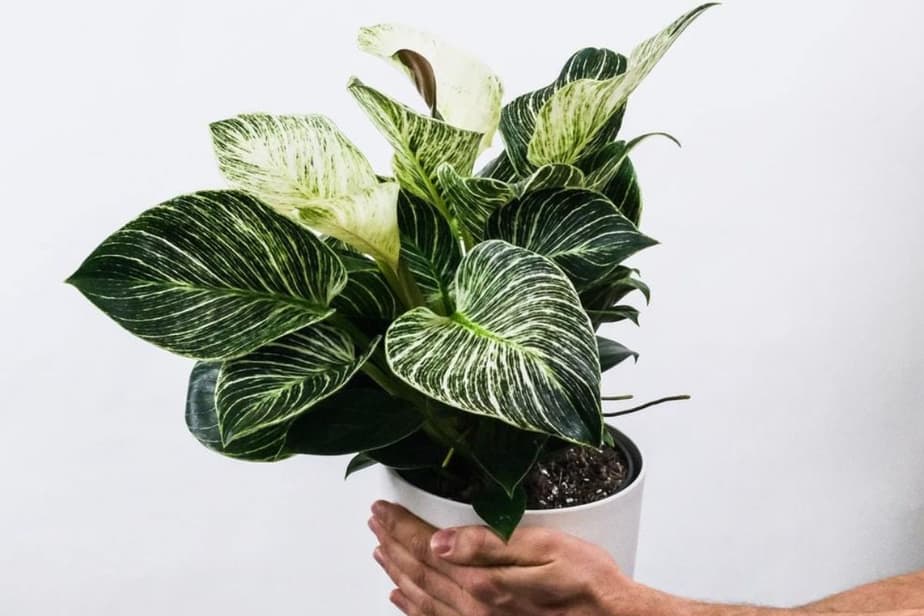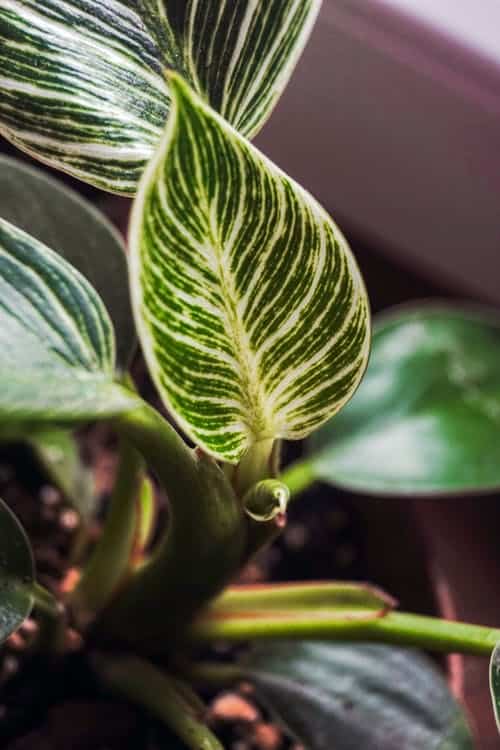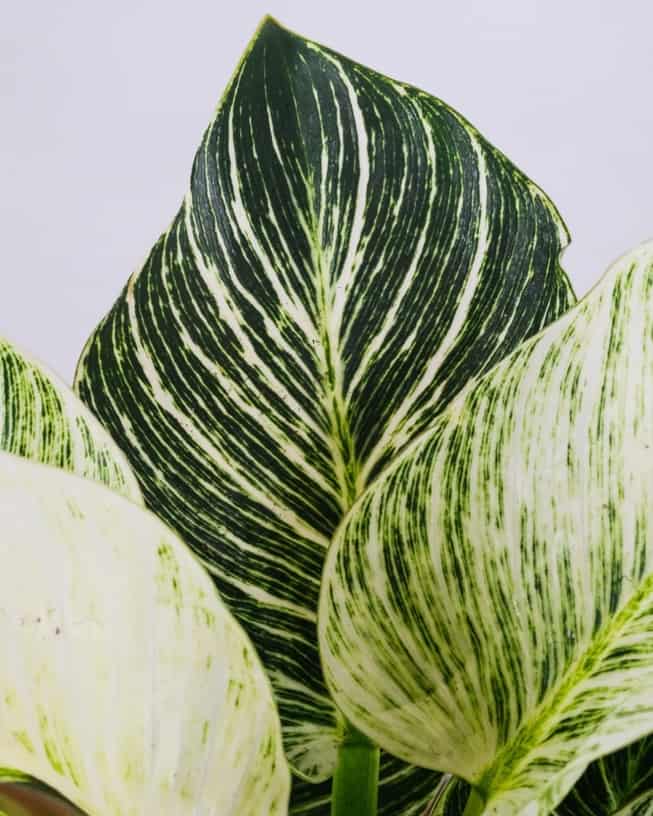What kind of care should I give to my Philodendron Birkin? How often should I water them? What should I feed them?
The Birkin is an easy to grow houseplant and requires little maintenance. This guide will cover philodendron Birkin care and how to get started growing them.
Philodendron Birkin Overview
The Philodendron Birkin is a relatively new member of the well-populated Philodendron plant family. A hybrid philodendron named after the famous Hermès designer purse, this man-made hybrid is a unique houseplant perfect for brightening up any office or home.
Also known as the Philodendron White Wave, or the Birkin White Wave, it is a member of the Araceae family, an aroid plant.
The Birkin does not have a native habitat as it is a hybrid plant. It’s a result of a spontaneous mutation of the Philodendron Rojo Congo, which is another man-made patented cultivar in the rather large selection of Philodendron varieties available.
Nonetheless, the Philodendron is a tropical plant, and other cultivars similar to the Birkin can be found in the northern part of the South American continent.

The Philodendron Birkin has dark green waxy leaves with a unique white striped variegation, making it a stunning houseplant.
One interesting characteristic of this plant is its ability to change its variegation. Various Birkins have been known to turn completely green, produce white foliage or even feature a spot of pink, contributing to its originality and flair.
Although it’s not a great climber, the Birkin will develop aerial roots and hook onto surfaces, especially textured ones.
Philodendron Birkin Care Guide
Caring for the Philodendron Birkin is simple.
Soil for the Philodendron Birkin
The Birkin Philodendron likes loose, airy soil that is moist and well-draining. You may want to purchase an aroid soil mixture or blend your own potting mix.
You can make your own by mixing 50% potting soil with the remaining 50% made of sphagnum moss for moisture retention and orchid bark for drainage. Other options include a two-thirds potting mix and one-third perlite, or two-thirds peat and one-third perlite.
Birkin plants can be planted in plastic or terracotta pots as long as they have a sufficient number of drainage holes. If you select terracotta, consider that your soil may dry out faster than a plastic pot because it absorbs water, so keep an eye on when you need to water.
Light for the Philodendron Birkin
Like so many tropical plants, the Birkin thrives when exposed to bright, indirect sunlight. Direct sunlight exposure should be avoided because it can scorch the foliage.
If your Birkin has lots of white in its leaf variegation, it will require brighter indirect light for continued healthy growth.
Plants may be positioned near windows, so that your Birkin receives sufficient light for growth. Your plant can be closer to the window in winter and a bit farther away during the warmer months when the sun is hottest. A risk of too little light is that the Birkin may lose its variegation.
Water and Humidity for the Philodendron Birkin
The Birkin likes moist soil, but it should be permitted to dry out a bit between waterings. They can survive drought better than overwatering.
The top inch of the soil bed should dry out before the plant is watered again. Placing your finger an inch into the soil bed will give you an idea of how much moisture there is in the soil.
When it is time to water, soak your plant thoroughly and let all excess water drain out before returning it to its location. You can bottom water your plant by placing it in a dish of water and allowing your plant to soak up the water it needs from the bottom of the pot.
The Philodendron Birkin is not overly sensitive to the type of water used. However, it’s best to use collected rainwater or distilled water if you can. Tap water will contain minerals like fluoride and chlorine. Leaving tap water to sit out for 24 hours or more can help the minerals dissipate from the water.
As a tropical plant, the Birkin enjoys a high humidity environment. Humidity levels measuring 40% or above will be fine. If you can raise humidity levels to between 50% and 70%, your Birkin will thrive even more. You can use a hygrometer to measure humidity.
If you need to improve the humidity near your plant, there are several options for doing so.
- Place your plant in a bathroom
- Use a humidifier in the space
- Use a pebble humidity tray underneath your plant
- Group several house plants together for shared transpiration and evaporation
Temperature for the Philodendron Birkin
Because the Philodendron Birkin’s ancestors (mother plants) are tropical, your Birkin will not appreciate the cold. A normal home room temperature will be fine for this houseplant. When you are comfortable, your plant will be as well.
Avoid letting your Birkin sit in a space with a temperature that is less than 60° Fahrenheit. Below 50° F, your plant will probably suffer cold damage and not survive.
On the other end of the temperature range, it should not rise above 85°F. The important thing with higher temperatures is that your plant is not exposed directly to the sun.
Drafts can be a problem to. Your Birkin should be protected from heating and air conditioning units and vents, and drafty windows, doorways, and corridors.

Fertilizer for the Philodendron Birkin
Feed your Philodendron Birkin with a liquid fertilizer monthly. Ideally, do this when watering. A balanced 20-20-20 fertilizer diluted to half strength will be sufficient.
You can also use organic fertilizer, but it may work a bit slower. You can also add 10% of compost to potting soil when repotting. There’s no need to fertilize in the winter months during its dormant period.
Pruning the Philodendron Birkin
The Birkin does not require a great deal of pruning. It’s sufficient to remove dead or dying foliage as necessary. Use sterilized garden shears or scissors when pruning.
Repotting the Philodendron Birkin
The Birkin tolerates repotting well. It is a relatively rapidly growing plant, so it’s wise to check your plant annually for signs of the plant being rootbound.
If your plant’s roots peep out of the drainage holes, you know it’s time for repotting. Repot in a new container with the pot size being one to two inches larger than its current pot.
Propagating the Philodendron Birkin
Propagating a Birkin is easier than you might think, even if you are new to indoor gardening. The simplest and easiest method is through stem cutting.
Propagate the Birkin with Stem Cuttings
To propagate with a stem cutting:
- Trim a piece of stem that has several leaves attached.
- Remove the lower leaves near where you cut the stem.
- Place the cut end into a jar of water or directly in a container with moist potting soil mix for aroids.
- Place the cutting in a location that is humid with bright indirect light. If you are cultivating in soil, keep the soil bed moist.
- If you are cultivating them in a jar of water, transplant them into the soil once new roots have grown an inch or so in length.
Philodendron Birkin Toxicity and Pets
The American Society for the Prevention of Cruelty to Animals (ASPCA) indicates Philodendrons are toxic to pets because their sap contains calcium oxalate crystals.
Calcium oxalate crystals will lead to swelling and burning both externally and internally if your pet comes into contact with them or ingests them.
Symptoms can have an effect on the mouth, throat, tongue, and skin. Swelling, can complicate vocal functions and breathing. If ingested in a sufficient quantity, they are lethal.
Poisoning symptoms to watch for include:
- Lack of appetite
- Sores in the mouth area
- Pawing at the face and mouth
- Difficulty swallowing
- Drooling or salivation
- Swollen mouth, tongue, or lips
- Vomiting
After the first bite, your pet may leave the plant alone due to the burning sensation. Death can result if enough foliage is eaten.
If your pet has ingested Philodendron, rinse the mouth and skin right away. If swelling occurs, a veterinarian should be contacted. In the event of severe symptoms, take your pet to an animal emergency hospital.
It’s best to place your Philodendron Birkin in a hard-to-reach location.

Philodendron Birkin Pests, Diseases, and Problems
The Philodendron Birkin is a resilient and hardy plant, but can be susceptible to the typical pests and diseases that commonly affect houseplants.
Philodendron Birkin Diseases
The principal risks of disease with your Birkin are caused by overwatering.
Root Rot
This is probably the most frequent disease issue for the Birkin. Root rot can develop from overwatering, poor drainage, an excessively large pot, or cold temperatures.
Root rot symptoms include wilting, stunted growth, brown leaf tips, yellow leaves, or other discolored foliage. When you look at the roots, they may appear blackened or mushy.
To treat this condition, remove the plant from the soil and trim away any damaged roots. Rinse off healthy roots and place the plant in fresh potting soil and perlite.
Wait a few days before watering again and take care not to exaggerate the watering again.
Bacterial Infections
Overwatering can also lead to Xanthomonas, also known as Leaf Spot. This will result in dark spots on leaves with yellow halos.
Another fungal infection is Erwinia or Bacterial Blight. Rapidly spreading dark spots are symptomatic. They lead to foliage collapse and death if not treated.
In the event of fungal or bacterial infections, prune the affected foliage and make sure your plant has optimal growing conditions.
Philodendron Birkin Pests
Spider mites, thrips, mealybugs, and scale insects are common pests to look out for with your Philodendron Birkin.
Spider mites may be one of the largest threats to your Birkin. Spider mites will eat foliage which will, in turn, dry up and drop.
They can be removed with a spray of water. Prune away the effected foliage and apply insecticidal soap. Isolate the Birkin from other houseplants, so the spider mites don’t spread to other plants.
Thrips are small yellow or black insects that negatively impact foliage, turning leaves splotchy and pale. Remove the affected leaves and apply insecticidal soap or organic neem oil.
Other pests include mealybugs and scale insects. Scale, brown waxy bumps on stems and leaves, can be removed by hand, as can mealybugs which appear as cottony deposits on your plant. Your plant should then be treated with insecticidal soap or neem oil.
Philodendron Birkin Final Thoughts
Enjoy the spectacular Philodendron Birkin with its exotic striped leaves. It’s an easy-to-care-for houseplant with distinctive white pinstripes that sets it apart from the crowd.
Other philodendron plants that you might be interested in:



